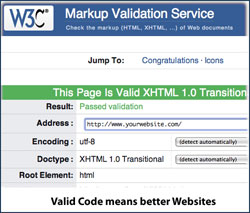Web Site Standards
What does Valid Code Mean?
What is Markup Validation?
Most pages on the World Wide Web are written in computer languages (such as HTML or XHTML) that allow web designers and authors to structure text, add multimedia content, and specify what appearance, or style, the result should have.

As for every language, these have their own grammar, vocabulary and syntax, and every document written with these computer languages are supposed to follow these rules. The (X)HTML languages, for all versions up to XHTML 1.1, are using machine-readable grammars called DTDs (Document Type Definition), a mechanism inherited from SGML (Standard Generalized Markup Language).
Text in a natural language can include spelling or grammar errors, documents using Markup languages may (for various reasons) not be following these rules. The process of verifying whether a document actually follows the rules for the language(s) it uses is called validation, and the tool used for that is a validator. A document that passes this process with success is called valid. One of the most common markup validation service is Validator.w3.org Try it out, just put in the url of the website you want to check and see how well the website was designed or how many errors the code contains when put to standards.
With these concepts in mind, we can define "markup validation" as the process of checking a Web document against the grammar (generally a DTD) it claims to be using.
Is Validation some kind of Quality Control?
Validity is one of the quality criteria for a Web page, but there are many others. In other words, a valid Web page is not necessarily a good web page, but an invalid Web page has little chance of being a good web page.
Why should I Validate my Website/Html Pages?
One of the important maxims or sayings of computer programming is: Be conservative in what you produce; be liberal in what you accept.
Web Browsers follow the second half of this saying by accepting Web pages and trying to display them even if they're not legal HTML. Usually this means that the browser will try to make educated guesses about what you probably meant. The problem is that different browsers (or even different versions of the same browser) will make different guesses about the same illegal construct; worse, if your HTML is really pathological, the browser could get hopelessly confused and produce a mangled mess, or even crash.
That's why you want to follow the first half of the maxim by making sure your pages are legal HTML. The best way to do that is by running your documents through one or more HTML validators.
Web Site Standards Overview
Validation is a process of checking your documents against a formal Standard, such as those published by the World Wide Web Consortium (W3C) for HTML and XML-derived Web document types. It is similar to spell checking and proofreading for grammar and syntax, but is much more precise and reliable than any of those processes because it is dealing with precisely-specified machine languages, not with vaguely defined human natural language.
When designing a website it is important to code to World Wide Web Consortium (W3C) standards for a number of reasons, there is no way to determine what type of computer, or Internet browser people will viewing your website on. Some people will use PC's with Internet Explorer 7, and others will view your website on a Macintosh using Safari. Resolution or monitor size is unable to determined because it is a personal user setting or preference. Following website design standards will help insure a website has a consistent look on any computer, including mobile telephones and PDA's.
Like anything else, the web is getting more and more intricate every day. The same goes for the standards used to create the Web. The earliest form of standards for the Internet was HTML. HTML is the basis that everything was created from then on and it worked great for giving text format. It was not so powerful working with images and the actual look of the web page. Since the dawn of the Internet, organizations like The World Wide Web Consortium have been working non-stop to make the Internet better.
Since the limitation of HTML is apparent, standards have changed to XHTML. Combining XHTML and CSS Web designers can create a consistent look with less code, and less code means faster loading web pages!
Another type of browser that will hit a website is a search engine crawler. A search engine crawler is a special type of browser that search engines (like Google) use to index the Internet. These crawlers do not look at the Internet like other browsers, in fact all they look for is text and links. In order to make the crawl faster, crawlers will have a limit of characters they will look at on any page. Following Standards and using the right techniques can help crawlers view only relevant information by allowing them to index more content on the pages in a website. This allows a website to get better results on the search engines index.
Webapplify validates web pages immediately after they are created to ensure no mistakes or being made and the code is valid on every web page in the website. Websites with valid code are more likely to appear higher up in search standings because the web browsers can easily decipher the correct elements the website contains.
For more information about web standards and the latest Web technology please visit World Wide Web Consortium (W3C). They provide many useful tools and information regarding website design standards and practices.




